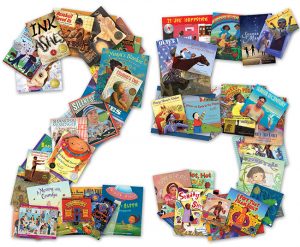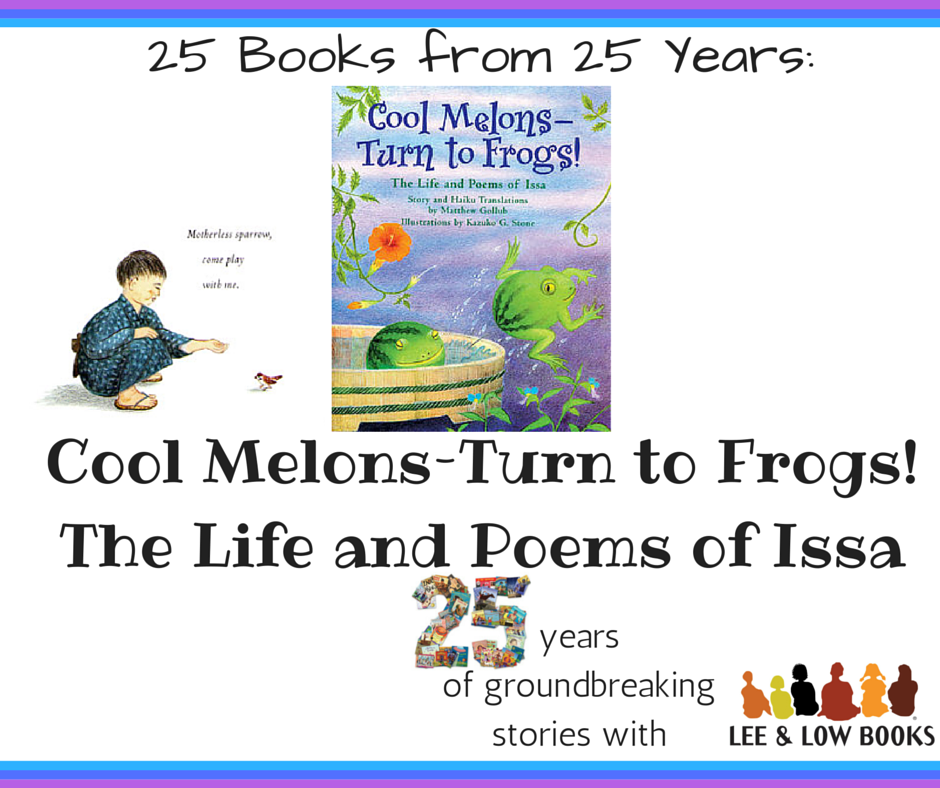 LEE & LOW BOOKS celebrates its 25th anniversary this year and to recognize how far the company has come, we are featuring one title a week to see how it is being used in classrooms today as well, as hear from the authors and illustrators.
LEE & LOW BOOKS celebrates its 25th anniversary this year and to recognize how far the company has come, we are featuring one title a week to see how it is being used in classrooms today as well, as hear from the authors and illustrators.
Featured title: Cool Melons–Turn to Frogs! The Life and Poems of Issa
Author: Matthew Gollub
Illustrator: Kazuko G. Stone
 Synopsis: This award-winning book is an introduction to haiku poetry and the life of Issa (b. 1763), Japan’s premier haiku poet, told through narrative, art, and translation of Issa’s most beloved poems for children.
Synopsis: This award-winning book is an introduction to haiku poetry and the life of Issa (b. 1763), Japan’s premier haiku poet, told through narrative, art, and translation of Issa’s most beloved poems for children.
Author Matthew Gollub’s poignant rendering of Issa’s life and over thirty of his best-loved poems, along with illustrator Kazuko Stone’s sensitive and humorous watercolor paintings, make Cool Melons—Turn to Frogs! a classic introduction to Issa’s work for readers of all ages. With authentic Japanese calligraphy, a detailed Afterword, and exhaustive research by both author and illustrator, this is also an inspirational book about haiku, writing, nature, and life.
Awards and honors:
- Notable Books for a Global Society, International Literacy Association (ILA)
- Notable Children’s Books in the Language Arts, National Council of Teachers of English (NCTE)
- Notable Children’s Trade Books in the Field of Social Studies, Children’s Book Council (CBC) and National Council for the Social Studies (NCSS)
- Children’s Books Mean Business, Children’s Book Council (CBC)
- Not Just for Children Anymore selection, Children’s Book Council (CBC)
- Outstanding Merit, Children’s Book of the Year, Bank Street College of Education
- Best Children’s Books of the Year, Bank Street College of Education
- Books to Read Aloud with Children of All Ages, Bank Street College of Education
- “Editor’s Choice,” San Francisco Chronicle
- Bay Area Book Reviewers Association Award finalist
- Children’s and Young Adult Honorable Mention for Illustration, Asian Pacific American Award for Literature (APAAL)
- “Choices,” Cooperative Children’s Book Center (CCBC)
- ALA Notable Children’s Book, American Library Association (ALA)
- A Horn Book Fanfare Best Book of the Year, The Horn Book Magazine
- California Collections, California Readers
- Utah Children’s Book Award Masterlist
- Children’s Book of Distinction, Poetry Finalist, Riverbank Review
- Read-Alouds Too Good to Miss, Indiana Department of Education
- Starred Review, Publishers Weekly
- Starred Review, The Horn Book Magazine
From the author: “A haiku, because of its brevity, resembles a quick line sketch. It’s up to the reader to imagine the details and to make the picture complete. In a sense, we can think of a haiku as a telegraph; for example: “Should arrive Tuesday, supper time.” From this short message, we can infer that, weather permitting, the sender will arrive early on Tuesday evening, and that after the long, tiresome journey she would appreciate a good meal.
Often, haiku describe two events side by side, such as: “Plum tree in bloom—/ a cat’s silhouette/ upon the paper screen.” Does the silhouette of the plum tree also appear on the paper screen? Does the plum tree in bloom suggest the warmth of a spring day? Again, it’s up to the reader to imagine how or if the two things are related.
Haiku tend to be simple and understated, so there’s never one “correct” way to interpret them. The idea is to ponder each poem’s imagery and to discover and enjoy how the poem makes you feel.”
–Matthew Gollub, from “What is a Haiku?“
Read about the origins of Cool Melons–Turn to Frogs! from Matthew Gollub here.
Resources for teaching with Cool Melons–Turn to Frogs! The Life and Poems of Issa:
- Check out the classroom-tested, standards-aligned lesson plan Experiencing Haiku Through Mindfulness, Movement & Music by Rashna Wadia with Cool Melons— Turn to Frogs! provided by ReadWriteThink.org, a website developed by the International Literacy Association and the National Council of Teachers of English.
- With students, try “4 Haiku-Sparking Activities” from author Matthew Gollub.
- Celebrate Japanese poetry and Japan’s Kodomonohi (Children’s Day) with the “Carp Streamer” lesson plan from Crayola, which includes Cool Melons–Turn to Frogs.
- Explore the range of poetry forms including haiku with “4 Mentor Texts and Activities for National Poetry Month” from LEE & LOW BOOKS
- Teach students to write a haiku and create an ink painting to illustrate their poem with the “Haiku Straw Painting” lesson plan from KinderArt.
- Check out the Teacher’s Guide from LEE & LOW BOOKS for interdisciplinary activities and learning.
- Read the reflection on Cool Melons–Turn to Frogs! from Matthew Gollub
Book activity:
Expand students’ experience with haiku by having them read and discuss works by other seventeenth century and eighteenth century poets such as Basho, Jöso, Ryota, Buson, or Sanpu. Students may also enjoy reading more contemporary haiku and comparing the contemporary poetry with the more traditional.
 How have you used Cool Melons–Turn to Frogs! The Life and Poems of Issa? Let us know!
How have you used Cool Melons–Turn to Frogs! The Life and Poems of Issa? Let us know!
Celebrate with us! Check out our 25 Years Anniversary Collection.








